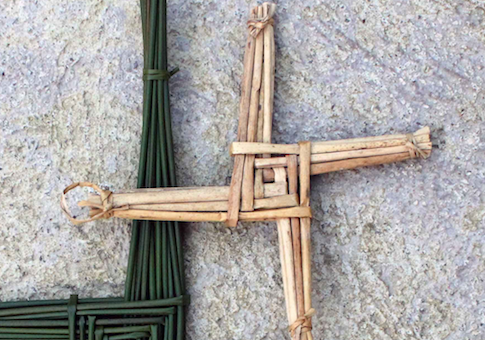Once upon a time I was reading a newspaper story about middle-aged women into Wicca, casting spells, and running about the woods naked in the moonlight. I laughed but my wife was more sympathetic: "They obviously didn't get to go to summer camp."
I thought of that as I read about W.B. Yeats, George Russell, and other mostly Protestant members of the Celtic Revival trying to contact the Irish god Lug and goddess Brigit via ecstatic trances. If they had been Catholics they wouldn't have needed to go to all that trouble; they would have had a host of saints, angels, and the Virgin Mary to consort with, not to mention pilgrimages, beads, scapulars, medals, and holy wells.
But therein lies the problem for the scholar of Irish mythology: the Church absorbed and transmuted the mythology for her own purposes. Thus the pantheon of Irish gods and goddesses, most of them local and tied to geography, never had a chance to solidify into well-delineated forms as, say, the Greek and Nordic pantheons did. "They are," Mark Williams writes in his book, Ireland's Immortals, "simultaneously a pantheon and a people," that is, fairies but also gods.
There is "an enigmatic and patchy archaeological record," of references to the "Túath Dé," "the semi-divine 'god-people,'" but for writings about them we only have the Church's witness and she was not interested in mythology per se but in either demonology and/or theological speculation, on the one hand, and literature, on the other.
The first half of this book describes how Irish gods and goddesses were seen via written records up until the end of the Middle Ages; the second half covers the modern era when the language changed from Latin and Irish to English, and notable writers such as Yeats and Russell came to the fore.
The first half reads a bit slow but is enlivened by what Williams calls the "ferocious weirdness" of Irish mythology and his own eye for wit and irreverence, such as when he quotes a "law-tract" from the early eighth century which "lumps" druids with "satirists and inferior poets and farters and clowns and bandits and pagans and whores and other bad people." The upshot of the first part is that "the more we know about early Irish learned culture, the less we can say with confidence about ancient Irish paganism." It has all been filtered through the sieve of the Church.
Which is, perhaps, why it was Irish Protestants who tried to revive the ancient ways. The Protestant like Yeats and Russell were trying to find the richness of lore, the rootedness in the land, they sensed they were missing, whereas Catholics, such as Austin Clarke, who contributed to the Celtic Revival, were revolting against the rather Jansenist forms Irish Catholicism has been known to take.
This second part is more interesting to the general reader because we know better the clerks trying to sing the gods and fairies of Ireland into being. Williams thinks most of this work, immensely popular at the time, was a failure overall, a "classical pastiche," though he singles out as successes, James Stephens' novel The Crock of Gold, some of Austin Clarke's work, Liam O'Flaherty's The Ecstasy of Angus, Alan Garner's The Weirdstone of Bisingamen and Pat O'Shea's The House of the Morrigan, the latter two being books for children featuring the Irish goddess known as the Morrigan, a lady with whom you don't want to tangle.
Williams also discusses the work of J.R.R. Tolkien who "affected distaste" for "'Celtic' craziness," which for him was all "bright colour but no sense." His elves, with their conditional immortality and beauty, their longing for a lost homeland, their skill in learning and the arts, however, are clearly drawn from Irish mythology:
Like the Túatha Dé, the elves are poignantly poised on the cusp of fading from the world altogether, either about to depart for a realm of existence . . . never again accessible to mortals, or to diminish into invisibility. It is ironic that the elves were clearly Tolkien's favourite creation, present in his thinking . . . from his early twenties until his death; he spent many thousands of hours elaborating and revising their histories in a way that would have seemed familiar to the likes of Flann Mainistrech or Gilla Cóemáin, back in the eleventh century.
So, if you are a scholar or an admirer of Irish mythology, or just one of those "nutters, regressives and the unbalanced" that the feminist mythologist Angela Carter said were attracted to "faery," this book will feed your hunger. No need to go to adult summer camps.
